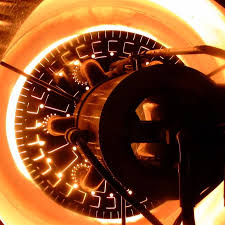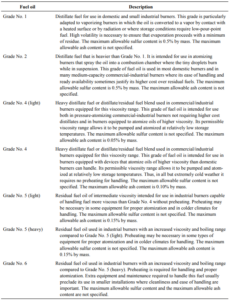In this article we will discuss a few different types of boiler fuels and their characteristics. Many burners will run on one or more of these fuels. Dual fuel burners or even triple fuel burners are not uncommon in certain situations. Here are the most common types of boiler fuel we see in the field:
1. Natural Gas
As a rule of thumb, natural gas has around 1000 BTU/cuft. Some municipalities however will have higher or lower BTU ratings for their natural gas. This is because natural gas is made up of a mixture of several combustible gasses. Variance in BTU/cuft are extremely important when you are sizing a burner. The lower the BTU the more fuel you will need to inject to achieve the same output as a higher BTU content.
The ignition temperature for natural gas is 1200 degrees Fahrenheit.
2. Propane
When we are talking about propane as a vapor it carries around 2550 BTU/cuft. Propane can make a great standby fuel for companies who use natural gas. This is because you can often inject propane into the fuel supply without changeover or downtime. This also means facilities can switch to curtailment rate fuel and save a lot of money in some cases throughout the year.
The ignition temperature for propane is 875 degrees Fahrenheit.


3. Biogas
We commonly see this at rendering plants or food processing facilities where Biogas is a waste product of production. As a rule of thumb, this runs at about 750 BTU/cuft but will vary depending on the quality of the biogas being produced. Boilers that use this will generally require special burner controls. This is because burners are designed to operate with an unlimited fuel supply at a constant pressure. Managing the variations in pressure and biogas become critical. In situations where a dual fuel burner is used fuel priority also needs to be considered. The controls must know to give biogas the priority and burn the secondary fuel only as demand requires.
The ignition temperature for biogas is between 1,200 and 1,380 degrees Fahrenheit.
4. #2 Fuel Oil
This is a diesel fuel and has around 139,000 BTU/gallon. Unlike heavy oil, preheating is not necessary in most cases before feeding the #2 fuel oil into the burner. See ASTM fuel oil grades below for a more complete breakdown on the different types of fuel oil.
Ignition temperature for #2 fuel is 492 degrees Fahrenheit.
5. Heavy Oil
Due to EPA requirements, we don’t see this fuel used as much anymore. This burns at 145,000 BTU/gallon. One thing many people don’t realize is that the temperature of the oil as it enters the burner is extremely important. This is because it effects the viscosity of the oil. If the oil is too hot it may flow to quickly and if it is too cold it may flow to slow. This, in turn, will affect the flow into the burner and the size of the particles themselves. To have controlled and efficient combustion, temperature needs to be taken into account.
The ignition temperature for heavy oil is 765 degrees Fahrenheit.
6. Solid Fuels
This would be things like wood and coal. BTU’s will vary significantly based on moisture content. This is especially the case with wood. The ignition temperature for coal is 850 degrees Fahrenheit. Wood will vary but is commonly between 392 and 482 degrees Fahrenheit. Both of these fuels produce waste in the form of ash and tend to produce high emissions.
Manure is another, albeit less common and more complicated solid fuel, that we have seen occasionally as well. Because of the high moisture content, this can be somewhat of a challenge.
7. Tallow
This boiler fuel source is not in use much anymore. That is in large part to it being a messy process that requires more maintenance to clean the boilers out. This burns at around 125,000 BTU/gallon.
The ignition temperature for Tallow is 680 degrees Fahrenheit.
ASTM Fuel Oil Grades
Technical standards set by ASTM help to classify the different fuel oil grades. Because we did not break these down above, it is important to mention each grade to notate the distinctions. CED Engineering breaks them down in table below:


Boiler Fuel And Air Supply
The amount of air is another thing to consider when discussing boiler fuel. When the air to fuel ratio is outside of normal parameters, it can lead to poor combustion. If left unchecked, it can have more drastic effects, like causing carbon monoxide poisoning or even boiler explosions. Understanding gas flow rates and the appropriate air flow rates for different fuels is an essential part of burner installation.
The national board of boiler and pressure vessel inspectors also discuss the importance of factoring in boiler heat loss into your ventilation requirements:
“The amount of air required for ventilation and cooling in the boiler room is determined by the heat loss from the boiler shell or jacket, the boiler piping, breechings, stacks, and any other heat-generating equipment present in the boiler room. Heat loss from the boiler jacket could range from 1/2% to 4% of the boiler output, depending upon operating pressure or temperature, boiler size, type of construction, and insulation thickness. Typically, the larger the boiler the lower the loss as a percentage of boiler output. Boiler room temperatures at the burner fan inlet should be controlled between 50 °F and 100 °F in order to limit variability in the amount of combustion air delivered to the burner.”
Boiler Fuel Questions
Let the boiler experts at RasMech help answer any of your boiler fuel questions. Reach out for a free estimate or call us at 1-800-237-3141. Our team is here to help!


